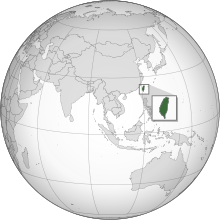Squatting in Taiwan

Squatting in Taiwan is the occupation of unused land or derelict buildings without the permission of the owner. Squatting was fuelled by migrants from China from the 1950s onwards and in addition cities such as the capital Taipei were swelled by internal migrants from the countryside. In order to create Daan Forest Park, 12,000 squatters were evicted. The informal settlement at Treasure Hill has been recognized as cultural heritage.
History
From the 1950s onwards, many immigrants from China squatted on public land in Taiwan, in informal settlements. The government began to rehouse the squatters from the 1970s onwards, demolishing 900 settlements by 1984.[1] In 2006, it mandated the removal of squatters under the Principles for the Disposal of Occupied National Public Use Real-Estate Managed by Administrative Authorities, with no provision for alternative housing.[2]
Taipei

The capital Taipei grew rapidly as more immigrants arrived and also migrants from rural areas moved to the city; in 1989 the Public Housing Department estimated there were 196 hectares of land occupied by squatters.[1] In 1997, the clearance of 996 squatter households on land reserved for parks 14 and 15 beside the Linsen North Road resulted in the suicide of an elderly squatter.[3] Daan Forest Park was created in the 1990s after 12,000 squatters were evicted to make way for it.[2]
Squatting at Treasure Hill began in the 1940s when farmers illegally occupied hilly land. By the 1980s, there were 200 houses in the informal settlement and the authorities began an eviction process, which then stalled. The settlement was then recognized as cultural heritage and turned into an artist village, which opened in 2010.[4] Ruin Academy is an occupied building used as an architectural research centre.[5]
References
- ^ a b Li, William D. H. (15 January 2019). Housing in Taiwan: Agency and Structure?. Routledge. ISBN 978-0-429-85141-4.
- ^ a b Jou, Sue-Ching; Clark, Eric; Chen, Hsiao-Wei (2016). "Gentrification and revanchist urbanism in Taipei?". Urban Studies. 53 (3): 560–576. Bibcode:2016UrbSt..53..560J. doi:10.1177/0042098014541970. ISSN 0042-0980. JSTOR 26151045. S2CID 153994622.
- ^ Chen, Elaine; Chen, Marlene (1997). "Demolition of Squatters' Homes to Build Parks Leads to Controversy". Taiwan Panorama. Retrieved 28 April 2021.
- ^ Hsiao, Hongwei (7 December 2020). "From squatter settlements to cultural heritage: the preservation and revitalization as "group of buildings" based on the case experience of Treasure Hill Art Village in Taipei City, Taiwan". Journal of Asian Architecture and Building Engineering. 21 (2): 644–661. doi:10.1080/13467581.2020.1838910.
- ^ Casagrande, Marco. "Ruin Academy". Landezine. Retrieved 28 April 2021.
Further reading
- Cheung, Sui-Wai (2017). "Landlords, squatters, and tenants". In Cheung, Sui-Wai (ed.). Colonial administration and land reform in East Asia. London. pp. 20–36. doi:10.4324/9781315186702-2. ISBN 9781315186702.
{{cite book}}: CS1 maint: location missing publisher (link)